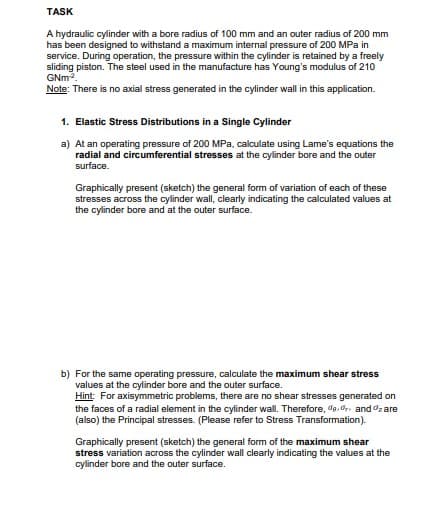A hydraulic cylinder with a bore radius of 100 mm and an outer radius of 200 mm has been designed to withstand a maximum internal pressure of 200 MPa in service. During operation, the pressure within the cylinder is retained by a freely sliding piston. The steel used in the manufacture has Young's modulus of 210 GNm-². Note: There is no axial stress generated in the cylinder wall in this application. 1. Elastic Stress Distributions in a Single Cylinder a) At an operating pressure of 200 MPa, calculate using Lame's equations the radial and circumferential stresses at the cylinder bore and the outer surface. Graphically present (sketch) the general form of variation of each of these stresses across the cylinder wall, clearly indicating the calculated values at the cylinder bore and at the outer surface. b) For the same operating pressure, calculate the maximum shear stress values at the cylinder bore and the outer surface. Hint: For axisymmetric problems, there are no shear stresses generated on the faces of a radial element in the cylinder wall. Therefore, and are (also) the Principal stresses. (Please refer to Stress Transformation). Graphically present (sketch) the general form of the maximum shear stress variation across the cylinder wall clearly indicating the values at the cylinder bore and the outer surface.
A hydraulic cylinder with a bore radius of 100 mm and an outer radius of 200 mm has been designed to withstand a maximum internal pressure of 200 MPa in service. During operation, the pressure within the cylinder is retained by a freely sliding piston. The steel used in the manufacture has Young's modulus of 210 GNm-². Note: There is no axial stress generated in the cylinder wall in this application. 1. Elastic Stress Distributions in a Single Cylinder a) At an operating pressure of 200 MPa, calculate using Lame's equations the radial and circumferential stresses at the cylinder bore and the outer surface. Graphically present (sketch) the general form of variation of each of these stresses across the cylinder wall, clearly indicating the calculated values at the cylinder bore and at the outer surface. b) For the same operating pressure, calculate the maximum shear stress values at the cylinder bore and the outer surface. Hint: For axisymmetric problems, there are no shear stresses generated on the faces of a radial element in the cylinder wall. Therefore, and are (also) the Principal stresses. (Please refer to Stress Transformation). Graphically present (sketch) the general form of the maximum shear stress variation across the cylinder wall clearly indicating the values at the cylinder bore and the outer surface.
Mechanics of Materials (MindTap Course List)
9th Edition
ISBN:9781337093347
Author:Barry J. Goodno, James M. Gere
Publisher:Barry J. Goodno, James M. Gere
Chapter8: Applications Of Plane Stress (pressure Vessels, Beams, And Combined Loadings)
Section: Chapter Questions
Problem 8.5.32P
Related questions
Question

Transcribed Image Text:TASK
A hydraulic cylinder with a bore radius of 100 mm and an outer radius of 200 mm
has been designed to withstand a maximum internal pressure of 200 MPa in
service. During operation, the pressure within the cylinder is retained by a freely
sliding piston. The steel used in the manufacture has Young's modulus of 210
GNm-2
Note: There is no axial stress generated in the cylinder wall in this application.
1. Elastic Stress Distributions in a Single Cylinder
a) At an operating pressure of 200 MPa, calculate using Lame's equations the
radial and circumferential stresses at the cylinder bore and the outer
surface.
Graphically present (sketch) the general form of variation of each of these
stresses across the cylinder wall, clearly indicating the calculated values at
the cylinder bore and at the outer surface.
b) For the same operating pressure, calculate the maximum shear stress
values at the cylinder bore and the outer surface.
Hint: For axisymmetric problems, there are no shear stresses generated on
the faces of a radial element in the cylinder wall. Therefore, der and are
(also) the Principal stresses. (Please refer to Stress Transformation).
Graphically present (sketch) the general form of the maximum shear
stress variation across the cylinder wall clearly indicating the values at the
cylinder bore and the outer surface.
Expert Solution
This question has been solved!
Explore an expertly crafted, step-by-step solution for a thorough understanding of key concepts.
Step by step
Solved in 4 steps with 2 images

Follow-up Questions
Read through expert solutions to related follow-up questions below.
Follow-up Question
Can i have this written up by hand, as viewing like this is confusing to me.
Solution
Knowledge Booster
Learn more about
Need a deep-dive on the concept behind this application? Look no further. Learn more about this topic, mechanical-engineering and related others by exploring similar questions and additional content below.Recommended textbooks for you

Mechanics of Materials (MindTap Course List)
Mechanical Engineering
ISBN:
9781337093347
Author:
Barry J. Goodno, James M. Gere
Publisher:
Cengage Learning

Mechanics of Materials (MindTap Course List)
Mechanical Engineering
ISBN:
9781337093347
Author:
Barry J. Goodno, James M. Gere
Publisher:
Cengage Learning